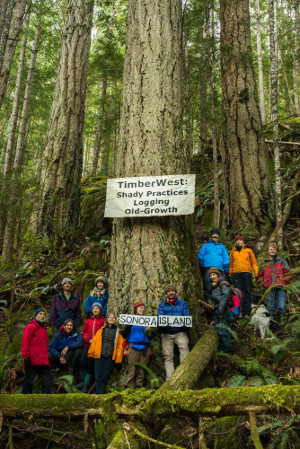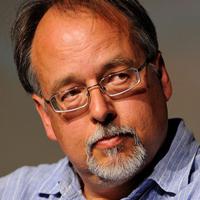
When is a grove of 600 to 800-year-old Douglas Fir trees not an old growth forest?
That's the question the Campbell family and other residents on Sonora Island will ask TimberWest Forest Corporation, western Canada's largest timber and land management company, at a meeting today in Campbell River.
TimberWest, owned by two pension funds, bills itself as "a leader in sustainable forest management and is committed to Vancouver Island communities."
It also says it practices "stewardship that maintains biodiversity."
But the Campbells and other coastal residents contend that the company's cutting practices are not as sustainable as advertised.
At issue are groves of stunning old growth fir and cedar on southeast side of Sonora Island, just northeast of Campbell River on Vancouver Island.
Because TimberWest owns renewable Crown harvest rights to an area that falls partly within the southernmost boundary of the Great Bear Rainforest, it must manage these forests according to Ecosystem Based Management (EBM).
It's a government approved land use system that manages human activities such as logging in a way that "ensures the co-existence of healthy, fully functional ecosystems and human communities."
When the provincial government implemented EBM in 2009, the rules stated that 30 per cent of each original forest type had to be left intact at a bare minimum to conserve ecological integrity.
Although adhering to this principle has been touted as a success by government and industry, the Campbells say it's not being honoured or enforced.
In fact they've been raising concerns about the logging of old growth forests in the region since the 1990s.
In particular they are concerned about the survival of small groves of untouched coastal Douglas fir and cedar, that now exist, much like plains buffalo, at less then one per cent of their historic prevalence, on the islands and adjacent Mainland coast.
Residents challenged TimberWest
Due to past logging, Sonora Island lies within an area where the goal of saving 30 per cent of these ancient trees remains far below target.
But in a July 2010 letter TimberWest announced plans to log on the island in an area containing many ancient trees.
Rick Monchak, operations manager for TimberWest, assured the Campbells in the letter that, "All of the proposed development is within second growth [already logged] timber and should be well away from the watersheds..."
Last year the Campbells and other families challenged the veracity of the company's assessment.
The company pushed in a logging road anyway.
In February of last year the Sonorans then hiked and explored the laid-out cut-block.
There they found survey tape labeled "Falling Boundary" wrapped around ancient stands of Douglas fir and cedar.
Some of the untouched groves contained huge trees measuring up to eight feet in diameter and over 200 feet tall. Depending on their quality some of the trees could be worth tens of thousands of dollars.
Altogether the Campbells measured and catalogued 160 massive trees in one single cut-block and took pictures.
"We were furious," says Fern Kornelsen another long time Sonoran resident.
Shortly afterwards, at a meeting in the TimberWest office in Campell River, senior registered professional foresters tried to assure the Campbells that the approved cutblock consisted of "second growth timber."
"Oh those are big trees they said, looking at the photos, but there are not enough of them," they told the Campbells.
Later, on a trip taken with the Campbells to the area in question, a TimberWest forester admitted "this is the nicest and largest area of this type of old growth in the landscape unit."
Company officials then explained that their definition of old growth was a forest with more than 50 percent of the stand volume belonging to trees over 250 years old.
Forest Practices Board bows out
The Forest Practices Board was then called upon to help mediate the dispute.
But the board withdrew two months later, issuing a statement to the Sonorans, saying, "We agreed that now is a good time for the Board to pull back from direct involvement to allow you a chance to resolve your concerns with TimberWest."
"We thought the board would reprimand the company and uphold the law," said Jody Eriksson, another Sonoran resident, "but that didn't happen."
The issue, however, soon caught the attention of Greenpeace, Forest Ethics Solutions, and the Sierra Club and other industry watchdogs.
They wanted to know if the principles of EBM were being enforced in other parts of the Great Bear Rainforest.
They also wondered if TimberWest had tailored a definition of old growth that allowed them to search out and cut the last remaining stands of old forest by calling them second growth.
"How did TimberWest pull that off?" asked Valerie Langer of Forest Ethics Solutions in a blog post. "By using a bizarre, technically unheard of, definition they made up."
In April 2013 the Sonora residents commissioned, at a cost of several thousand dollars, an independent environmental assessment by Madrone Environmental Services Ltd.
The 77-page report, which called for better mapping and verification of old growth on the island, concluded the proposed cut-block was indeed old growth:
"Based on the data collected, we conclude that the sampled 5.6 ha area of Sonora 11-370 West consists of 'old forest' as that term is intended to be understood for the purposes of the Objectives for landscape level biodiversity under South Central Coast Order."
Doug Hopwood, one of the co-authors of the report and a Registered Professional Forester, noted that he was "unable to find any documented scientific basis" for the TimberWest's definition of old growth.
Definition 'in progress': TimberWest
TimberWest says a relevant definition for old growth has yet to be nailed down.
In a response to Tyee inquiries, Domenico Iannidinardo, vice president of sustainability and chief forester for TimberWest explained the company "voluntarily deferred harvest and began working with the Sonora Island community to develop a definition for old growth stand that the parties could agree to. An independent specialist was jointly retained to oversee development of the definition, a piece of work that is in progress."
The company's chief forester added, "that the Forest Practices Board, the Province and First Nations are aware of the joint work on the old growth stand definition. The province also has a representative on the team that is working on the definition of old growth stand. Once the definition has been developed it will be shared with the Province and First Nations."
But the Sonorans feared that TimberWest would continue to cut the few remaining stands while negotiating the new definition.
On Oct. 14, 2013 Iannidinardo promised that wouldn't happen.
He explained in a letter that the company would follow "a precautionary approach while this work on the definition of an old growth stand continues in adherence to the South Coast Conservation Order."
In addition "we have no plans to harvest stands in the Thurlow [includes Sonora] and Grey Landscape Units that will or might have the potential to meet the final definition of an old growth stand."
Members of the Sonora community then travelled to a familiar patch of rare old growth in the Grey Landscape Unit on the Mainland to see if TimberWest kept its word.
That's where they say they found a recent cut-block full of tall, straight, giant trees dominated by Douglas fir over 500 years old and equally impressive stands of western red cedar.
Unfortunately, they claim, the trees were already felled and lying on the ground.
The community is meeting with TimberWest on Jan. 24 to discuss the company's reasons for the cutting of so many ancient trees.
TimberWest's Iannidinardo told The Tyee the company is "engaged in complex discussions with our neighbours on Sonora Island on a range of issues pertaining to the Gray Landscape Unit including the definition of old growth stand. As part of the discussions we are providing answers to a number of questions raised by the Sonora Island community."
'Where is the government?'
Ross Campbell, a business owner and long-time Sonoran resident wants to see more government involvement on the issue.
"Our government relies on timber companies' commitment to 'Professional Reliance' to ensure the health and future of our public forests, but with practices such as TimberWest's it is clear the spirit and intent of EBM is not being upheld in the woods."
Added Ross: "And just where is the government?"
Other members of the community said protecting ancient trees is one thing but policing forest companies in order to enforce provincial law is another issue altogether.
"That job that should not fall on the shoulders of citizens but appears to be required with so little government oversight or enforcement," said Farlyn Campbell, a life-time Sonora resident.
TimberWest is owned by two Canadian pension funds, the British Columbia Investment Management Corporation and Public Sector Pension Investment Board.
The company says its goal is to "earn an international reputation as an environmentally responsible supplier of forest products through stewardship of its lands." ![]()
Read more: Labour + Industry, BC Politics, Environment
















Tyee Commenting Guidelines
Comments that violate guidelines risk being deleted, and violations may result in a temporary or permanent user ban. Maintain the spirit of good conversation to stay in the discussion.
*Please note The Tyee is not a forum for spreading misinformation about COVID-19, denying its existence or minimizing its risk to public health.
Do:
Do not: